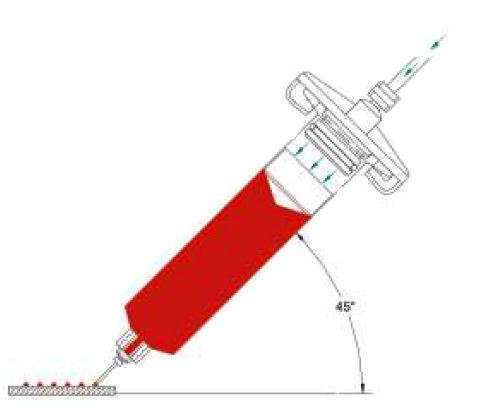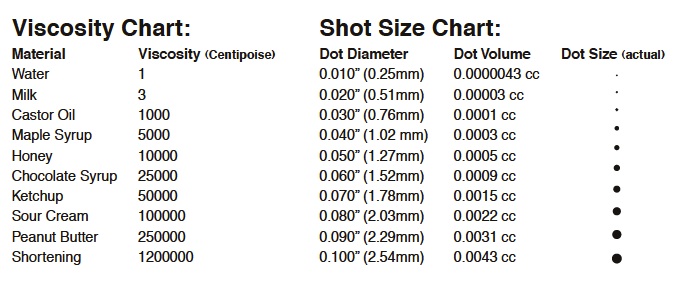|
Tutorial
Time-Pressure Dispensing
Time pressure dispensing is the most common dispensing method used today. Its popularity stems from the need for process control and the fact that it is possible to dispense from disposable containers without the need for cleaning.
Our time-pressure dispensers deliver a measured amount of air pressure, for a measured amount of time, to a pre-filled syringe barrel. This controlled shot of air pressure forces material out of the delivery end of the barrel, through a dispensing tip, and out to the application surface.
Factors Affecting Dispensing
� PRESSURE: Increasing fluid pressure will increase dot size and vice versa
� TIME: Increasing dispense time will increase dot size and vice versa
� NEEDLE SIZE: Larger inside diameter (orifice) needle results in bigger dot size

Basic Dispensing Guidelines:
� SMALL SHOT SIZE = small needle, low fluid pressure, short dispense time
� LARGE SHOT SIZE = larger needle, higher fluid pressure, longer dispense time
� LOW VISCOSITY FLUID = small needle, low pressure, time as required
� HIGH VISCOSITY FLUID = larger needle (tapered needles recommended), high pressure, time as required
� Position dispensing device at 45� angle
� Position the needle close to the work surface then activate the dispense cycle and keep the dispensing device in the same position until the cycle is completed
� If vacuum �suck-back� is needed, use only enough vacuum to draw back fluid into dispense tip. Excessive vacuum could draw air into the fluid and also could draw fluid into the dispenser.


| Related Articles |
> How to attach the adapter assembly hose to the syringe barrel
> How to connect dispenser to external source using I/O Configuration
> Watery liquid drips from either TS250, TS255, TS350, TS355 syringe dispensers
> Thick paste, gels, silicones, sealants, epoxies, etc not flowing or restricted when dispensing
> Filling techniques for syringe barrels
> Advice for dispensing different fluid types
> Advice for dispensing sealants, grease and solder pastes
> Smooth flow tapered tips
> Bench-top fluid dispensing: Easy when you know how
> Dispensing System: Reducing maintenance requirements in dispensing applications
> Piston Comparison for 700 Series Dispensing Syringes
> Rotary Auger Valves � Pros and Cons
> Dispensing Adhesives Material Can Be Challenging
> Improving the Grease Dispensing Process
> Benchtop epoxy dispensing small shot
> The Negative Effects of Reusing Syringes and Accessories
> Fluid Viscosity Chart Table
> Dispense valve material selection guide
> TS5600 series diaphragm valves specifications
> TS5420 needle valve specifications
> TS5520 spray valve specifications
> TS1212 pinch tube valve specifications
> TS1201 pinch tube pen valve specifications
> Fluid dot anatomy volume compared to deposit diameter
> General advice for handling Cyanoacrylates in bottles
> Avoid needle tips clogging using Cyanoacrylate adhesives
> Basic TS250/ TS255 bench dispensers manual applications
> Reason to use a brush tip with a timed pulse dispenser
> If you use Cyanoacrylates...
> Some typical dispensing applications
> Reducing Hand Fatigue and Variability in Medical Device Assembly Processes
> General advice for handling Cyanoacrylates adhesives
> Viscosity of Fluids to Compare With
> Dispenser spares & accessories
> Spray Valve Coverage Chart
> Techcon cartridge gun spares & accessories
> Techcon spool valve spares & accessories
> Techcon spray valve spares & accessories
> Techcon needle valve spares & accessories
> Fisnar peristaltic pump spares & accessories
> Dispensing tip gauge size chart
> Benchtop dispensing robots
> Dilatent Definition
> Conformal Coating Product Description - a brief guide
> Potting Encapsulating Product Description - a brief guide
> Sealants Product Description - a brief guide
> Adhesive Technical Information Chart
> Adhesive Dispensing Valve Selection Guide
> Chemistry Technical Information
> Volume, Weight and Length Conversions
> Temperature Conversions
> Durometer Conversions
> Fluid Coverage Information
> Adhesive Dispensing Luer Lock & Luer Slip Tip Attachment
> Accelerator Definition
> Activator Definition
> Acrylic Definition
> Alloy Definition
> Anaerobic Definition
> Aqueous Definition
> Balling Definition
> Braze Paste Definition
> Caulk Definition
> Centipoise Definition
> Conductive Epoxy Definition
> Cyanoacrylate Definition
> Epoxy Definition
> Hot Melt Definition
> Polyurethane Definition
> Silicone Definition
|
|